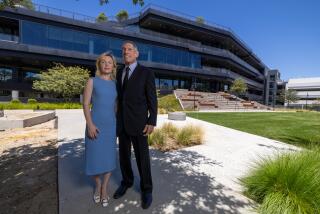Diamond-Tooth Charlie would have appreciated what’s become...
- Share via
Diamond-Tooth Charlie would have appreciated what’s become of his street corner.
A modern dental center sits on the site where Diamond-Tooth Charlie--Dr. Charles William Bryson--opened Los Angeles’ second medical school as well as the hospital that for years was praised as the city’s best--Angelus Hospital.
At the turn of the century, when the growing population of the City of Angels had reached 150,000, Bryson (better known by his nickname, which arose because of the sparkler in one front tooth) joined four other investors. They pooled their resources to build a badly needed sanctuary for the sick, injured and dying a few blocks south of downtown.
Angelus Hospital opened Oct. 8, 1905. The three-story facility was built and fitted out for the then-astonishing sum of $175,000. Its location, at Washington Boulevard and Trinity Street, was close to streetcar lines and only a few blocks from an amusement park and baseball stadium.
Architect John Austin, known as the dean of California architects, designed the hospital in the Beaux Arts classical style, featuring Corinthian columns, ornate parapets and brick walls with granite trim.
The hospital boasted its own 255-foot well, dissecting room, power plant, and ice-making and cold storage buildings. Next door on Washington Boulevard was the College of Physicians and Surgeons, which Bryson’s group had built two years earlier.
The medical students, starting with a handful and growing to 30 by 1905, spent part of their studies working as interns in the hospital next door. The tuition for the medical training course was about $500.
Bryson had come to Los Angeles as a young medical school graduate. In 1886, four years after he finished his studies at the Iowa College of Physicians and Surgeons, he moved west to begin a private practice as an abdominal surgeon and gynecologist.
He attracted notice from the start. He was a handsome man with a stylish mustache that he waxed and curled at the ends--and the diamond set in his tooth, which flashed wickedly in the sunshine. He made his rounds with a matched pair of white horses harnessed to a fancy rig with no top, a sort of early California convertible.
Bryson became dean of the medical school he helped build and served from 1909 until 1920 as dean and professor of medicine. By then, the medical school was forced to close because World War I had taken its toll on the ranks of prospective physicians. Bryson died in 1928.
Key alumni such as Pierre Paul Viole, whose wife’s family founded the venerable restaurant Taix, were credited with reopening the medical school at USC in 1928. The old school building eventually became dormitories for student nurses.
The hospital remained open throughout World War I and the Jazz Age.
During the Depression, the hospital opened its wards to what The Times described as the “great in-between class of sufferers, who are not objects of charity but have fallen under the extraordinary stringency of the
times.” Hospital rates ranged from $39.65 to $75 per week, with “no extra costs attached.”
Over the years, the hospital went through several name changes: the American Hospital, Mid-City Hospital and finally, by the 1980s, the Central City Community Mental Health Center.
In 1985, the building was condemned.
Nowadays, where horses and buggies and streetcars once ran,
where the cries of newborns could be heard from the sidewalks and streets, thousands of cars whiz by the Centro Medico Familiar Clinica Dental that was built atop the historical site.
But the corner also serves more than dental needs: A check-cashing office, Payless Shoes, El Pollo Loco, and other businesses and restaurants fill the vast plot where Diamond Tooth’s hospital and medical school once stood.
More to Read
Sign up for Essential California
The most important California stories and recommendations in your inbox every morning.
You may occasionally receive promotional content from the Los Angeles Times.













